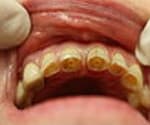Managing Dental Erosive Tooth Wear: Current Understanding and Future Directions
Course Number: 517
Course Contents
Key Differences Between Dental Caries and Dental Erosion
Generalities can be confusing. Caries is often described as the loss of minerals by the direct action of acids on the teeth, and dental erosion is also defined in a similar way. While both statements are true, of primary importance is the type of acid, where the acid comes from and specific sites on the tooth surface to which these acids are directed. It is important to differentiate enamel damage due to caries vs. damage that results from dental erosion. Both the etiology and symptoms of these two processes differ significantly, as do the appropriate management strategies for each (Table 3).
One major difference between caries and dental erosion needs to be clearly understood. Caries is a process that begins with demineralization and, at early stages, can be reversed, either through the natural process of remineralization or through enhanced remineralization due to fluoride therapy. Dental erosion, on the other hand, is essentially a non-reversible process that results in permanent damage to the tooth structure.
Table 3. Key Differences Between Caries and Dental Erosion.
 |  |  |
|---|---|---|
| Key Comparisons | Cavities | Erosion |
| Type of process | Mineral Change | Mineral Loss |
| Tooth site(s) affected | Enamel & dentin | Enamel & dentin |
| Primary cause | Bacterial acids | Dietary acids |
| Primary site(s) of damage | Subsurface, under plaque | Exposed, plaque free surface |
| Conditions | Exposure to weak acids for prolonged periods of time, usually at a pH above 4.0 | Repeated exposure to dietary or gastric acids, generally below pH 4.0, for short time periods |
| Result | Sub-surface phenomenon with intact outer layer of enamel | Surface softening leading to loss of surface mineral |
| Reversible? | Reversible in early stages | Irreversible surface loss |
| Contributing factors | Buffering by saliva helps neutralize bacterial acids | Saliva and pellicle overwhelmed by dietary and gastric acids |
| Preferred therapeutic approach | Prevention as well as reversal of early damage | Prevention is critical for managing |
| Fluoride effectiveness | ------------ | ------------ |
| Sodium fluoride | Yes | Yes |
| Sodium monofluorophosphate | Yes | Minimal |
| Stannous fluoride | Yes | Yes |

